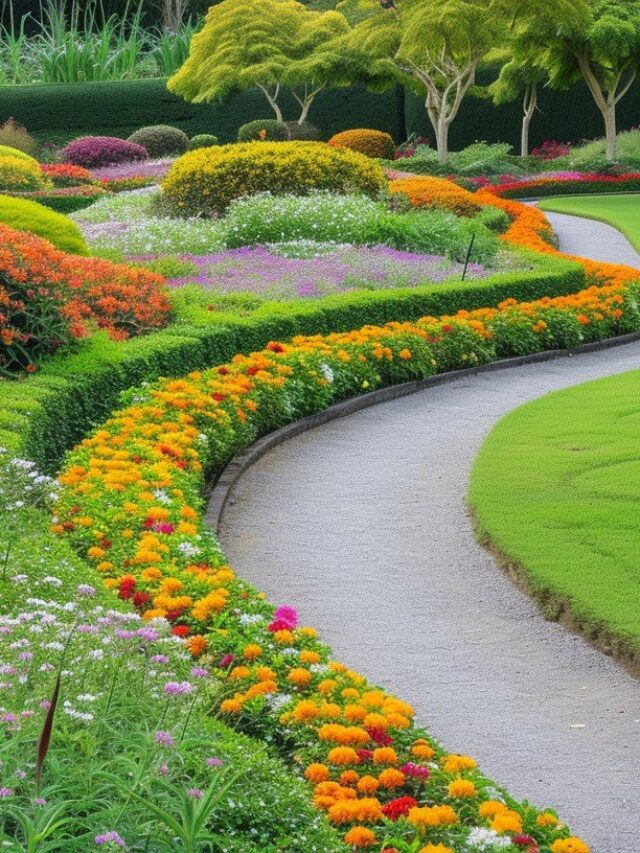1. Introduction to Flower Garden Designs
Flower garden designs are a great way to enhance outdoor spaces, creating a tranquil and beautiful environment. Whether you have a small yard or large area, planning a garden layout with a variety of flowers can bring vibrancy and life to any space. Thoughtful design includes selecting the right plants for your climate, soil conditions, and preferred aesthetic. With the right planning and ideas, you can turn your outdoor area into a floral paradise that blooms through the seasons, providing endless enjoyment and beauty throughout the year.
2. Choosing Seasonal Flowers for Year-Round Beauty
To maintain a colorful garden year-round, it’s essential to choose seasonal flowers that bloom at different times. Spring blooms like tulips, daffodils, and peonies add early color, while summer welcomes sunflowers, lavender, and roses. For fall, chrysanthemums and asters keep the garden lively. Selecting perennials ensures continuous growth, while annuals can add a fresh touch every season. By planning your garden with seasonal changes in mind, you’ll ensure a garden that’s always full of vibrant flowers, offering a changing display of color and texture throughout the year.
3. Flower Garden Layout Ideas for Small Spaces
For small spaces, creative garden layout ideas are key to making the most of every inch. Vertical gardens, hanging flower baskets, and tiered flower beds help maximize space while creating visual interest. Use borders along fences or walkways to add color without overwhelming the area. Opt for compact, easy-to-maintain flowers like pansies, geraniums, and petunias. Containers and pots also work well for small gardens, allowing flexibility in rearranging the layout. By using height and structure wisely, even a tiny outdoor space can become a thriving, colorful garden.
4. Designing a Low-Maintenance Flower Garden
Busy lifestyles often call for low-maintenance flower gardens that still deliver beauty without constant upkeep. To achieve this, opt for hardy perennials like lavender, coneflowers, and sedum that thrive with minimal care. Use mulch to retain moisture and reduce the need for frequent watering. Plant flowers in groups based on their water and sunlight needs to simplify maintenance. Native plants are also a great option since they naturally thrive in local conditions. With smart plant selection and design, you can enjoy a flourishing garden that requires little effort.
5. Incorporating Water Features into Flower Gardens
A well-placed water feature can transform a flower garden into a peaceful retreat. Whether it’s a small fountain, pond, or birdbath, water adds an element of tranquility and visual appeal. Water features also attract wildlife, such as birds and butterflies, enhancing the natural beauty of your garden. Surrounding the water feature with bright flowers like lilies, irises, or water-loving plants creates a harmonious look. Even in smaller gardens, a modest water feature can elevate the overall design, offering a serene escape in your own backyard.
6. Creating Flower Beds with Color Schemes
Color schemes play a vital role in the overall impact of your flower garden. Coordinating colors brings harmony, while contrasting shades can add drama. Monochromatic gardens using different shades of one color, like all whites or all purples, give a sophisticated look. Alternatively, vibrant combinations like yellow and purple or red and white can create stunning visual interest. Consider the mood you want to create when planning your color palette—soft pastels for a calming atmosphere or bold colors for energy. A well-thought-out color scheme transforms an ordinary garden into a work of art.
7. Utilizing Vertical Flower Garden Designs
Vertical flower garden designs are perfect for adding height and depth to your space, especially if you have limited ground area. Trellises, wall-mounted planters, or hanging baskets are great ways to grow flowers vertically. Plants like climbing roses, clematis, or morning glory are ideal for creating vertical layers of blooms. Vertical gardens are also excellent for privacy, serving as a colorful screen around seating areas. This design approach adds dimension, maximizes your gardening space, and creates a beautiful layered effect with cascading flowers.
8. Mixing Perennials and Annuals for Variety
Combining perennials and annuals in your flower garden design provides both stability and variety. Perennials like daisies, phlox, and hostas return year after year, giving your garden a foundation of reliable blooms. Annuals such as marigolds, zinnias, and snapdragons add fresh bursts of color each season, allowing for creativity and change. This combination ensures that your garden maintains a continuous cycle of growth while offering new blooms every year. It’s a great way to keep your garden fresh, vibrant, and evolving with each season.
9. Flower Garden Pathway Ideas
Adding pathways to your flower garden enhances both function and design. Pathways guide visitors through your garden while offering a structured contrast to the softness of the blooms. Materials like gravel, stepping stones, or bricks create beautiful walkways that integrate seamlessly with flower beds. Plant flowers along the edges of pathways to create a sense of flow, guiding the eye along the path. Curved pathways offer a more natural, relaxed feel, while straight paths provide a more formal look. A well-placed pathway makes your garden more inviting and accessible.
10. Using Native Plants in Flower Garden Designs
Native plants are an excellent choice for any flower garden design, as they’re naturally adapted to the local climate and require less maintenance. Flowers like black-eyed Susans, coneflowers, and milkweed thrive in many areas of the USA and attract pollinators like bees and butterflies. These plants are more resistant to pests and diseases, reducing the need for chemical treatments. Using native flowers also supports local ecosystems and creates a garden that is not only beautiful but also sustainable. They’re an eco-friendly choice for creating a resilient and low-maintenance garden.


